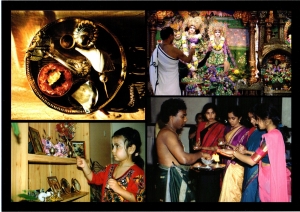6. Worship – Puja and Arti
 Download PDF: PCT-006 Puja & Arti
Download PDF: PCT-006 Puja & Arti
- Hindus worship at home and in the temple (mandir).
- Most Hindus believe in one God. They also believe that he appears in many different ways. These forms of God are called ‘deities’. A deity is a form of God, or of a god or goddess.
- The most important deities are:
- Rama and Sita – see Card number 10
- Krishna and Radha – see Card number 11
- Lakshmi – see Card number 12
- Vishnu – see Card number 13
- Brahma – see Card number 13
- Ganesh – see Card number 14
- Shiva and Parvati – see Card number 15
- Hindu people use sacred statues in their worship. The sacred statue is called the ‘murti’. The murtis are looked after in a shrine.
- This worship is called ‘puja’. The murtis are treated as if they are very special people; like kings and queens. They are woken in the morning, dressed, fed meals and put to sleep at night.
- At home, Hindu people often have small murtis or have pictures instead (a bit like we have photos of people we love).
- The main part of the worship is called arti. It is sometimes called ‘the ceremony of lights’.
- In the arti ceremony, a lamp is waved in circles in front of the murtis.
- The flame is then taken around the worshippers. They pass their hands over the flame. Then they touch their hands to their forehead. This is a sign of respect.
- The priest (or, at home, the person doing the worship) also gives other things to the deity. These include incense, a flower and water.
- Sometimes, while arti is going on, there is singing of a bhajan (religious song) or there is kirtan (chanting prayers with music).
- Before the arti ceremony, food is given to the murtis. Afterwards, it is thought to be special. It is then called ‘prasad’. Prasad means ‘mercy’ or ‘blessings’.
- For Hindus, there is no special day of the week (like Sunday is special for Christians). Morning time is most important. Everything is more peaceful at that time. It is a good time for worship and prayer.
